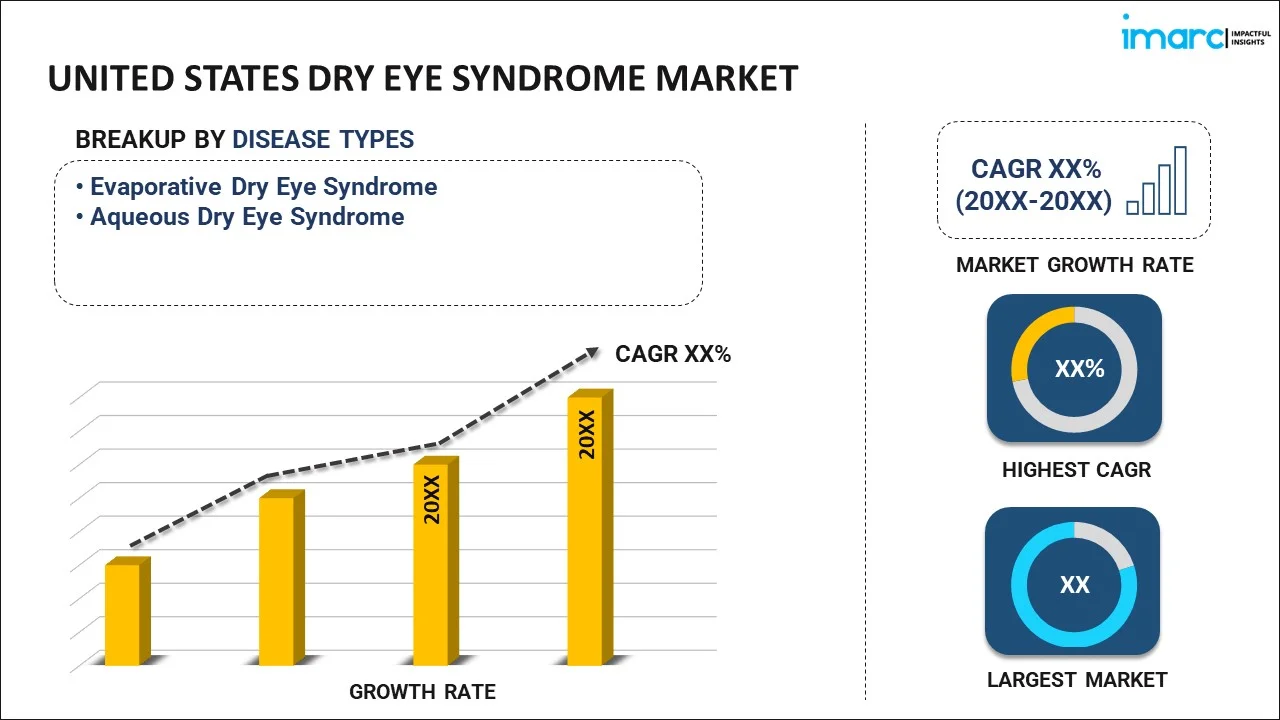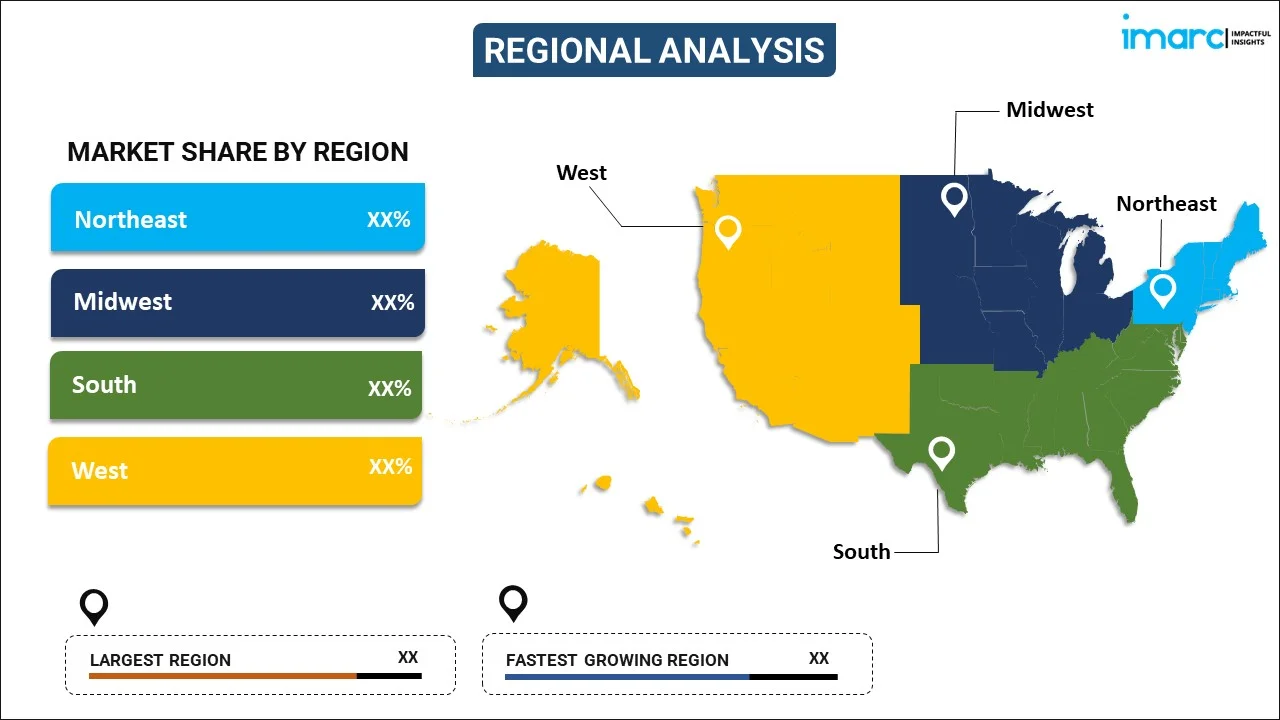
United States Dry Eye Syndrome Market Report by Disease Type (Evaporative Dry Eye Syndrome, Aqueous Dry Eye Syndrome), Drug Type (Anti-inflammatory Drugs, Lubricant Eye Drops, Autologous Serum Eye Drops), Product (Liquid Drops, Gel, Liquid Wipes, Eye Ointment, and Others), Distribution Channel (Hospital Pharmacies, Retail Pharmacies, Online Pharmacies), and Region 2025-2033
Market Overview:
The United States dry eye syndrome market size reached USD 2.7 Billion in 2024. Looking forward, IMARC Group expects the market to reach USD 3.9 Billion by 2033, exhibiting a growth rate (CAGR) of 4.15% during 2025-2033.
|
Report Attribute
|
Key Statistics
|
|---|---|
|
Base Year
|
2024
|
|
Forecast Years
|
2025-2033
|
|
Historical Years
|
2019-2024
|
|
Market Size in 2024
|
USD 2.7 Billion |
|
Market Forecast in 2033
|
USD 3.9 Billion |
| Market Growth Rate 2025-2033 | 4.15% |
Dry eye syndrome, or keratoconjunctivitis sicca (KCS), is a medical disorder that occurs due to the lack of adequate moisture or lubrication on the surface of the eyes. It is caused due to multiple factors, such as extensive computer usage, menopause, allergies, deficiency of vitamin A, laser surgeries and autoimmune diseases. Dry eye syndrome is characterized by various symptoms, including aching, burning, redness, itchy eyes, pain, discomfort and photophobia. It can be treated by administering artificial tears, surgeries, medications and lacrimal plugs. Dry eye syndrome can be prevented by wearing wraparound sunglasses or other protective eyewear and avoiding excessive smoking.
The growth in the United States dry eye syndrome market can be attributed to the changing lifestyles of the masses and the increasing utilization of electronic gadgets, such as laptops, smartphones and television, leading to excessive and prolonged screen time. In addition, the rising utilization of contact lenses is also increasing the occurrence of dry eye syndrome. The material of the contact lens limits oxygen flow to the cornea and dries up the surface of the eyes. However, various product innovations, such as the development of a neurostimulation device that stimulates the lacrimal gland to temporarily increase natural tear production, are providing a thrust to the market growth. In line with this, the rising geriatric population, which is prone to chronic eye-related diseases, is also contributing to the growth of the market. Dry eye syndrome is associated with various medical conditions, such as rheumatoid arthritis, lupus, scleroderma and diabetes, which can trigger the syndrome in elderly patients. Other factors, including the widespread adoption of corticosteroids drugs for effective treatment, along with significant improvements in the healthcare infrastructure and diagnostic technologies, are creating a positive outlook for the market.
Key Market Segmentation:
IMARC Group provides an analysis of the key trends in each segment of the United States dry eye syndrome market report, along with forecasts at the country and regional levels from 2025-2033. Our report has categorized the market based on disease type, drug type, product and distribution channel.
Breakup by Disease Type:

- Evaporative Dry Eye Syndrome
- Aqueous Dry Eye Syndrome
Breakup by Drug Type:
- Anti-inflammatory Drugs
- Lubricant Eye Drops
- Autologous Serum Eye Drops
Breakup by Product:
- Liquid Drops
- Gel
- Liquid Wipes
- Eye Ointment
- Others
Breakup by Distribution Channel:
- Hospital Pharmacies
- Retail Pharmacies
- Online Pharmacies
Breakup by Region:

- Northeast
- Midwest
- South
- West
Competitive Landscape:
The competitive landscape of the industry has also been examined along with the profiles of the key players.
Report Coverage:
| Report Features | Details |
|---|---|
| Base Year of the Analysis | 2024 |
| Historical Period | 2019-2024 |
| Forecast Period | 2025-2033 |
| Units | Billion USD |
| Segment Coverage | Disease Type, Drug Type, Product, Distribution Channel, Region |
| Region Covered | Northeast, Midwest, South, West |
| Customization Scope | 10% Free Customization |
| Post-Sale Analyst Support | 10-12 Weeks |
| Delivery Format | PDF and Excel through Email (We can also provide the editable version of the report in PPT/Word format on special request) |
Key Questions Answered in This Report:
- How has the United States dry eye syndrome market performed so far and how will it perform in the coming years?
- What has been the impact of COVID-19 on the United States dry eye syndrome market?
- What are the key regional markets?
- What is the breakup of the market based on the disease type?
- What is the breakup of the market based on the drug type?
- What is the breakup of the market based on the product?
- What is the breakup of the market based on the distribution channel?
- What are the various stages in the value chain of the industry?
- What are the key driving factors and challenges in the industry?
- What is the structure of the United States dry eye syndrome market and who are the key players?
- What is the degree of competition in the industry?
Need more help?
- Speak to our experienced analysts for insights on the current market scenarios.
- Include additional segments and countries to customize the report as per your requirement.
- Gain an unparalleled competitive advantage in your domain by understanding how to utilize the report and positively impacting your operations and revenue.
- For further assistance, please connect with our analysts.
 Inquire Before Buying
Inquire Before Buying
 Speak to an Analyst
Speak to an Analyst
 Request Brochure
Request Brochure
 Request Customization
Request Customization




.webp)




.webp)












